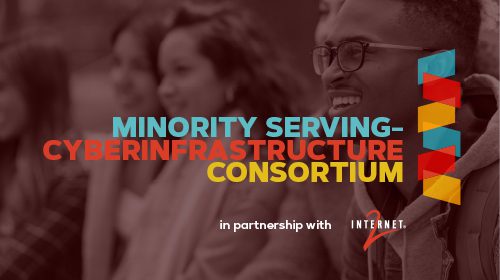Estimated reading time: 4 minutes
A $3 million National Science Foundation grant awarded to the Minority Serving – Cyberinfrastructure Consortium (MS-CC) and Internet2 will provide researchers, professional staff, and students from historically Black colleges and universities (HBCUs) and tribal colleges and universities (TCUs) with programs and services that address their cyberinfrastructure needs.
Campus Technology recently published a story to share more about the MS-CC’s efforts to address cyberinfrastructure barriers that prevent HBCUs and TCUs from achieving their primary data and research computing needs. It also shed light on the MS-CC survey conducted in December 2020, through which those needs surfaced.
“We’re working toward establishing shared research cyberinfrastructure across a distributed community of colleges and universities in a mix of urban, suburban, and rural settings, many of which are on the wrong side of the digital divide. We have the data and empirical evidence that show what the immediate cyberinfrastructure needs are and what barriers are preventing campuses from achieving them. This grant is helping us formalize how we support underserved institutions by funding programs and services that prioritize addressing these gaps.”
—Deborah Dent, Chief Information Officer at Jackson State University, and the NSF grant’s co-principal investigator.
“We’re keenly aware of the vast diversity in size and missions among HBCUs and TCUs in the United States, but see great potential in working collaboratively on shared research and education cyberinfrastructure challenges. This NSF grant will propel the synergy among the MS-CC, AIHEC, and Internet2, allowing us to create opportunities for members from HBCUs and TCUs, to get the resources, support, and training they need, all while building communities of practice and creating spaces where mentorship can flourish.”
—Ana Hunsinger, Vice President of Community Engagement at Internet2, and the NSF grant’s principal investigator.
- Read the story in Campus Technology.
- Read the formal announcement: Nearly $3 Million NSF Cyberinfrastructure Center of Excellence Pilot Aims to Advance Research Capabilities and Support Systems for HBCUs and TCUs
- Learn more about minority serving institutions in the U.S.: Pulling Back the Curtain: Enrollment and Outcomes at Minority Serving Institutions (Report, PDF)
- Learn more about Internet2’s work with the MS-CC to explore solutions that reduce the gap between minority-serving institutions and the global research and education ecosystem.

| What is a historically Black college or university? |
| Historically Black colleges and universities (HBCUs) were established in the United States early in the 19th century, to provide undergraduate and graduate level educational opportunities to people of African descent. Black students were unwelcome at existing public and private institutions of higher education, even after the passing of specific legislation, resulting in a lack of higher education opportunities. Approximately 89% of all HBCUs are in the southern region of the United States, although they can be found in Delaware, Illinois, Maryland, New York, Ohio, Pennsylvania, and West Virginia. HBCUs have diverse classifications: public, private, denominational, liberal arts, land-grant, independent university systems, single-gender serving, research-based, large and small, with enrollment numbers that can range from less than 300 to over 11,000 students. Source: Thurgood Marshall College Fund. |
| What is a tribal college or university? |
| Tribal colleges and universities (TCUs) are chartered by their respective tribal governments, including the ten tribes within the largest reservations in the United States. They operate more than 75 campuses in 16 states—virtually covering Indian Country—and serve students from well more than 250 federally recognized Indian tribes. TCUs vary in enrollment (size), focus (liberal arts, sciences, workforce development/training), location (woodlands, desert, frozen tundra, rural reservation, urban), and student population (predominantly American Indian). However, tribal identity is the core of every TCU, and they all share the mission of tribal self-determination and service to their respective communities. Source: American Indian Higher Education Consortium. |
| What is a Hispanic-serving institution? |
| Hispanic-serving institutions (HSIs) are defined as colleges, universities, or systems/districts where total Hispanic enrollment constitutes a minimum of 25% of the total enrollment. “Total Enrollment” includes full-time and part-time students at the undergraduate or graduate level (including professional schools) of the institution, or both (i.e., headcount of for-credit students). Source: Hispanic Association of Colleges and Universities. |
